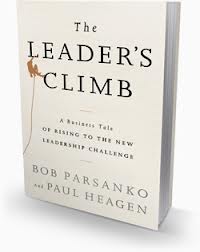The Leader’s Climb – Part 1

After enjoying an extended “blocation,” I’m excited to resume my Sunday morning blog posts. During the 4th quarter of 2012, I felt my work on Executive Street was getting stale. I was spending too little time reading and learning, and too much time espousing – my blog posts suffered as a result. I barely wanted to read them myself, let alone ask you to. So I took a break and began reading more – a great deal more. It’s time now to establish the proper balance between reading and writing. Being more of a thought follower than a thought leader, I look forward to sharing what I’ve learned.
spending too little time reading and learning, and too much time espousing – my blog posts suffered as a result. I barely wanted to read them myself, let alone ask you to. So I took a break and began reading more – a great deal more. It’s time now to establish the proper balance between reading and writing. Being more of a thought follower than a thought leader, I look forward to sharing what I’ve learned.
So to get started, let me share the work of Bob Parsanko and Paul Heagen by featuring their new book, The Leader’s Climb: A Business Tale of Rising to the New Leadership Challenge. In the tradition of Patrick Lencioni and Robert H. Thompson, the authors leverage a powerful metaphor within a fictional framework to share some very real lessons on leadership. It’s an absolute must read! Co-author Paul Heagen was kind enough to answer some questions for us here on Executive Street. In Part 1, Paul will offer us his thoughts why they chose to write a fictional narrative. In Part 2, he’ll share some insights and takeaways from the book Enjoy!
LB: Why did you choose fictional narrative as the device for illustrating the challenges that face a leader?
PH: We all respond better to stories, don’t we? We relate to characters and events in a more personal way, so we can more easily apply the lessons or understand how they play out in real life, rather than have to make the jump from abstract concept to application. One of the main points in the book is the need to slow down to sense or feel, not just think and act, so the fact that this is a novel—rather than just another business book you might flip through—invites that experience. It has been amazing how many people have come up to me after reading this and can replay specific scenes and characters that really resonated with them. That was our purpose.
LB: Tell us how your personal backgrounds informed the use of the prevailing metaphor in your story?
PH: We guard the confidentiality of our conversations with clients very highly, so there is nothing taken directly out of those experiences. Still, a lot of the dialogue and the people in the story do capture the essence of what we have seen in working with our clients over many years, which is what makes it so real. In particular, my co-author Bob and I have heard the voice of Adam in many ways when we meet with senior executives — they are well-meaning, talented, capable, but are going so fast they can barely hear themselves think. They even realize it at some level, but feel stuck in the cycle. A lot of what we do in coaching is exactly what the park ranger and the handyman in the story do with Adam – help him slow down and become more aware, more accepting of himself and the realities he faces, and more open to creating more choices in how to move forward.
On a personal level, people who know us figure out that Bob and I actually are pretty close to the two respective “coaches” in the story. The park ranger A.J. is an outdoorsman, a little quieter in manner and a great questioner, and Bob is very much that way. The handyman Duncan is a little more animated, sometimes more direct in approach, and tends to use humor and stories to make a point, which is what I’m known for.
As well, there are some pretty intense and also intimate scenes in the book, conversation between two people trying to understand each other and get through to each other. So many people have told me “Oh my, I had EXACTLY that same conversation with my spouse or child or board member or friend.” Of course, they did. We all have.
Join us next Sunday for Part 2!
Category: Leadership
Tags: Leadership, Robert H. Thompson

